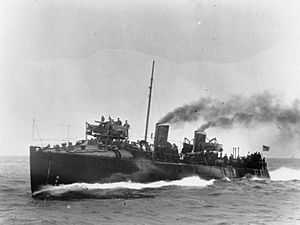HMS Desperate (1896) facts for kids

Fame, a ship just like Desperate
|
|
Quick facts for kids History |
|
|---|---|
| Name | HMS Desperate |
| Ordered | 10 May 1895 |
| Builder | John I Thornycroft, Chiswick |
| Cost | £54,579 |
| Yard number | 305 |
| Laid down | 1 July 1895 |
| Launched | 15 February 1896 |
| Commissioned | February 1897 |
| Out of service | Laid up in reserve 1919 |
| Fate | Sold for breaking, 20 May 1920 |
| General characteristics | |
| Class and type | Two funnel, 30 knot destroyer |
| Displacement |
|
| Length | 210 ft (64 m) o/a |
| Beam | 19 ft 6 in (5.94 m) |
| Draught | 5 ft 8 in (1.73 m) |
| Installed power | 5,700 shp (4,300 kW) |
| Propulsion |
|
| Speed | 30 kn (56 km/h) |
| Range |
|
| Complement | 65 officers and men |
| Armament |
|
| Service record | |
| Operations: | World War I 1914 - 1918 |
HMS Desperate was a fast destroyer (a type of warship) built for the Royal Navy in the late 1800s. She was known as a "30-knot" ship because of her speed. Launched in 1896, she served in different parts of the world, including the Mediterranean Sea, before World War I. During the war, she was based in Portsmouth, England. After the war, she was sold in 1920.
Contents
Building the Desperate
The ship was built at the John I. Thornycroft & Company shipyard in Chiswick, England. Her construction began on July 1, 1895. She was launched into the water on February 15, 1896. During her tests, she reached an amazing average speed of 30.3 knots. After her weapons were added in Portsmouth, the Royal Navy officially accepted her in February 1897. During her first sea trials, her average speed was about 25 knots.
In late 1902, Desperate received new spare boilers from the same company that built her.
Life at Sea: Desperate's Service
After joining the Royal Navy, Desperate was first sent to the Chatham Division of the Harwich Flotilla. On June 26, 1897, she took part in a special event. This was the Royal Naval Review at Spithead, celebrating Queen Victoria's Diamond Jubilee.
Early Duties and Training
In January 1900, Desperate moved to Sheerness. Here, she helped with training at the Sheerness school of gunnery. She acted as a support ship for HMS Wildfire. A couple of months later, she moved to Chatham. Her job there was to replace another destroyer, Spitfire, in the Medway Fleet Reserve.
Mediterranean Adventures
In April 1900, an accident occurred near West Pier, Brighton. A boat from the ship was swamped, and sadly, some sailors were lost. Later in 1900, Desperate was sent to the British Mediterranean Fleet. This fleet was based in Malta. In September 1901, Lieutenant Edward Oliver Gladstone became her new commander. In September 1902, she visited the Aegean Sea with other ships. They took part in practice exercises near Nauplia.
Desperate stayed in the Mediterranean until November 1913. Then, she was ordered to return to her home waters in England.
World War I Service
On August 30, 1912, the Admiralty (the government body in charge of the Royal Navy) decided to give all destroyer classes letters. Desperate was put into the D class. This was because she matched the design of other destroyers in that group. After September 30, 1913, she was known as a D-class destroyer. She even had the letter 'D' painted on her hull near the bridge and on one of her funnels.
In July 1914, just before World War I began, she was part of the Portsmouth Local Flotilla. When the war started in August 1914, she was actively serving. She was attached to HMS Excellent, which was the gunnery school in Portsmouth. Desperate stayed there for the entire First World War.
The End of Desperate's Journey
In 1919, after the war, Desperate was taken out of service. She was kept in reserve, waiting to be sold. On May 20, 1920, she was sold to a company called Thos. W. Ward from Sheffield. They broke her up for scrap metal in Milford Haven, Wales.
Ship's Numbers
Ships often have special numbers called pennant numbers. These numbers help identify them. Here are the numbers Desperate had:
| Pennant number | From | To |
|---|---|---|
| P50 | 6 December 1914 | 1 September 1915 |
| D40 | 1 September 1915 | 1 January 1918 |
| D26 | 1 January 1918 | 13 September 1918 |

